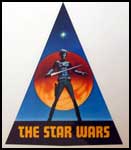
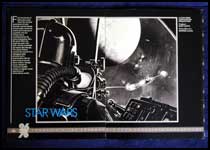
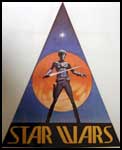

The groundwork for this edition of Relics was laid down in an article I wrote for The Star Wars Collector #25 back in 1998. Since then, several new pieces have found their way into my collection, most of which I was unaware of when I wrote that initial article. With Star Wars pre-release items so few and far between, the act of cataloging them has essentially become a waiting game. Scouring Ebay on a daily basis will typically yield me one new pre-release item per year to add to my collection. The trip to this now updated listing has been a long one, but it has definitely been worth the wait.
There is certainly a coolness factor associated with owning the first pieces ever to exhibit the Star Wars logo, which in its infancy would take on several imaginative guises. There's also a certain mythos associated with these items produced before May 25, 1977, by virtue of their insider nature. But whatever their appeal, they offer a unique insight into the development of the film's sometimes wayward ad campaign.
Strangely, the first item to bear the Star Wars title is among the easiest pre-release items to find today: an early sticker, bearing a graphic and the film's title. The Star Wars was the first working title given to episode four, and in its earliest incarnation the name lacked any unique stylization in logo form. The triangular image of a conceptual Luke with lightsaber was elegantly rendered by Ralph McQuarrie to lend an icon to the production, which was gearing up to begin shooting in early 1976. The sticker can be seen in many behind-the-scenes shots, most notably on the Panavision magazines in which the film was stored. These labels were printed in two sizes, 5 inches and 2.5 inches, and can frequently be found for sale on Ebay. It's said that the original stash found its way to the collector's market through none other than Star Wars producer Gary Kurtz.



By late 1975, Twentieth Century Fox had Star Wars on board, and devoted the last page of its "26 for 76" campaign book to the production, slotting it for a late 1976 release. This early plug is notable for two reasons: One, Luke still possesses his early "Starkiller" surname, and two, the artwork is an early black-and-white concept of what would become an exquisite MqQuarrie production painting. This book is exceedingly hard to find, most likely because Fox had no memorable submissions for 1976 that would have made the book a keepsake. And by the time Star Wars finally made the scene in '77, most of the books had already been trashed.
Sometime late in 1975, Fox made the decision to nix the "The" from the production's title, giving the Star Wars team an impetus to create a new logo. John Van Hammersveld designed an elegantly stylized logo, which proved an adequate replacement to the one that had earlier been featured below the artwork icon. This new composite is found on the first Star Wars crew t-shirts, which are displayed prominently throughout many early ILM staff photos. The actual iron-ons used for these tees have also made their way to the collectors market, again most likely through Kurtz.
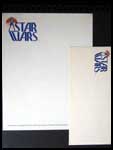
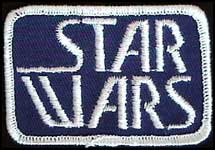

The new stylized lettering would also be used as stationary headers for the newly-founded Star Wars Corporation, as well as for the earliest crew patches. The first piece of merchandise designed for public consumption also carried the logo; it's scribed discreetly in the lower corner of the famous "Luke Skywalker Poster #1." This poster is highly coveted not only for its status as an early limited piece (1000 were printed), but also for its attention-grabbing design by famed comic illustrator Howard Chaykin. It was only available in the summer of 1976 at the Worldcon in Kansas City and the Comicon in San Diego. It seems to be the only piece of pre-release material specifically designed to evoke the swashbuckling appeal of Star Wars, probably because it was to target the comic book youth market. (The design would be translated in a slightly altered form onto the cover of Marvel's Star Wars #1, technically also a pre-release item, having first sold in March of '77.)
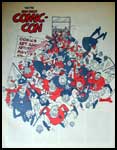
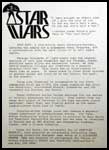
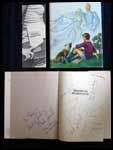
Also available at the Star Wars booths of these conventions was a two-sided flyer outlining the film's plot. It opens with the now famous Lucas invocation of Arthur Conan Doyle: "I have wrought my simple plan / If I give one hour of joy / To the boy who's half a man / Or the man who's half a boy." The two program books from these events offer little in the way of promoting Star Wars, except for a small blurb heralding the comic series in the Comicon program, and a discussion panel for "The Star Wars" listed on the agenda of the pocket guide for the Worldcon. Also of note is an interview with Mark Hamill, given at the Worldcon, which appears in an October 1977 issue of Rocket Blast Comic Collector. It features a nice photo of the article's author with Hamill in front of the banner.
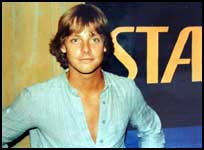
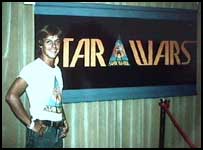
Late 1976 saw the novelization of Star Wars made available for the first time to eager Sci-Fi fans. Ralph McQuarrie painted an exquisite cover for this first edition. It featured an uninspired style of logo, one which could also be seen at the end of the first trailer hitting theaters that December. Running about two minutes and scored with a pre-John Williams piece (he wouldn't write the score until March of '77), this trailer conveys the epic tone and grandeur which would figure strongly in the ad campaign's marketing strategy. Though lacking Williams' masterful music, the trailer's temp track achieves a certain suspenseful tension that lends a mood unfamiliar to the footage but not unfitting. It actually seems to emulate some of the finer moments of the darker, moodier score for the The Empire Strikes Back.

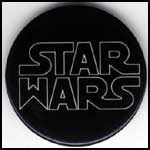

Some of the theaters that were exhibiting this early trailer were also given promotional pinbacks for distribution to their employees or guests. These were most likely commissioned by Fox, although no licensing information appears on the buttons. They featured yet another logo style, this one bearing the notorious "pointy W" that would become the most recognized feature of pre-release pieces. As its nickname suggests, this logo is identified by the lower extremities of the letter "W" in "Wars," which are pointed rather than flat. Also being showcased in these theaters were the first advance teaser posters, which were printed on heavy silver mylar stock. Designed by the ad agency of Doyle, Dane and Burnbach, these prestigious posters demonstrate the campaign's desire to portray Star Wars as an event film of cinematic weight and scope, a story of "a boy, a girl, and a universe." These posters are very difficult to find in pristine mint condition, as most have either delaminated (meaning the layers of the poster have become separated) or been pinned up in theater marquees. Again, the Gary Kurtz collection offered a handful of mint examples to the public through convention venues back in the early days of Star Wars fandom.
Another item which exhibits the "pointy W" logo style is the Star Wars campaign book, a lavishly illustrated large-format book, which loosely resembles the program that would be available after the film's release. However, the campaign book is distinguisted by its full-color spreads and formal composition, as well as by its white 11x14-inch box, which came with the film's logo banded around its middle. As might be expected, the box is a much tougher find than the book; it will double the value of the piece when present.
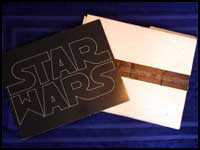
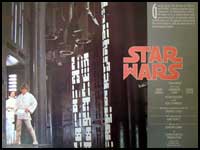
A book similar to the Fox "26 in 76" publication, but this one featuring the films of 1977, was printed in December. It's a much easier find than its predecessor. Also devoting a page to Star Wars, the 1977 book sells it as "an intergalactic civil war and the confrontations with the dark forces of an evil space empire." This book features the classic Fox fanfare logo on its cover and came in a cool nondescript wraparound folder that opens to reveal three semi-circular Fox logos holding the book within.
December also saw the placement of a Star Wars ad in trade magazines. It announced Fox's intention of releasing Star Wars in Dolby-encoded 70mm and 35mm prints. Considering that, at this time, the use of Dolby in films was still in its infancy, the ad is a noteworthy reminder of the trailblazing nature of Star Wars.
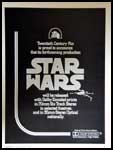
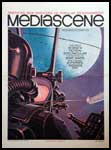
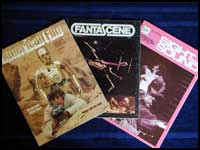
The first exclusive peek into the development and design of Star Wars was granted to Jim Steranko, editor of Mediascene magazine, which he featured prominently in the Nov/Dec issue of 1976. Its cover graced by a McQuarrie preproduction painting, the magazine showcases much of his work, as well as that of Joe Johnston and Ron Cobb. An interview with Roy Thomas on the upcoming Marvel series is included, as is a reproduction of Chaykin's first Star Wars poster. It also features a rare glimpse of Alex Tavoularis' storyboards for the opening sequence of Star Wars, which I believe has not been reprinted since. In addition, several prominent magazines, such as American Film and Sight and Sound, ran Star Wars stories prior to the film's release.
Also around this time, the second advance poster was issued. It was almost identical to the first, but without the slick mylar stock and with a slightly altered logo. Printed this time on a silver-gray paper stock, this logo features a drawn-in "W" which lends the title a more symmetrical balance. In fact, it was so successful that it became the standard logo, and has remained in use to this day. This poster is moderately common compared to the first, but still commands a lot of attention when brought to market. It's the next best thing to owning the mylar original.

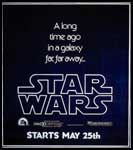
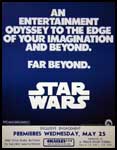
Still another advance poster would be introduced in early 1977, this one using the now familiar "A long time ago in a galaxy far, far away..." bi-line. Printed in blue with white lettering, the seven-sheet version of this poster has the distinction of being the only formal piece of advertising material which provides the famous May 25th opening date . The one-sheet version is tough to find unfolded (rolled bootlegs abound), while the seven-sheet exists only in four separate folded sections. My copy was actually rescued from the dumpster at Fox, and has "Trash--please throw away" scribbled on the back!
In the area of street advertising, at least three different flyers were produced to drum up interest in the film. One simply exhibits the film's title in silver on blue; another uses the quickly withdrawn teaser "An entertainment odyssey to the edge of your imagination and beyond. Far beyond"; while still another settles on the familiar "A long time ago..." slogan printed in white on blue. These occasionally come up mint with the bottom quarter blank, but I prefer to find them with the venue and May 25 release date noted, thereby securing their status as pre-release collectibles.
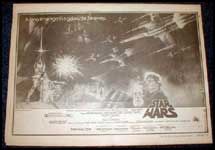
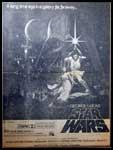
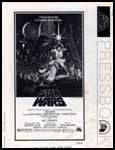
In the final month before Star Wars' release, materials and special screenings were provided to members of the press to promote the film. The first newspaper ads appeared on May 15th, exploding into major markets with a two-page spread of Tom Jung's lavishly epic artwork, the same artwork that later graced the cover of the program book and half-sheet poster. It is notable that both the newspaper ad and the program book utilized the illustration as it appeared before George Lucas insisted that the droid duo, R2-D2 and C-3PO, be added to the design (the pair do appear in the artwork as it appears on the half-sheet poster).
The newspaper ad campaign also marked the premiere of yet another logo variation, the familiar "space crawl" design which graced all original Star Wars release posters in 1977 (except the 24-sheet billboard--more on that later). Ad slicks featuring the famous Hildebrandt artwork of Luke with raised saber were distributed to the press, but were quickly replaced by an altered "droids added" version. Apparently, Lucas insisted the droids be added to this poster version as well. I have searched high and low for the original slick without the droids, but have never seen one offered. The only testament to its existence is the full-page newspaper ad printed the Sunday before the film's release.
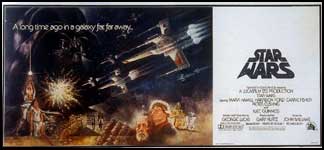
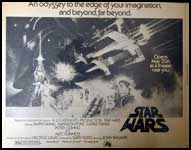
The common Hildebrandt "with droids" version is also found on the cover of the Star Wars pressbook, and although it is dated with a 1976 copyright, it was actually printed in 1977 after the painting was completed in April. The pressbook contains 19 pages of blurbs, articles, and biographies for syndication, as well as a preview of the poster imagery to be used. What is noteworthy about the latter is that none of the previewed posters resemble their release counterparts. The one sheet would use Tom Jung's artwork instead of the Hildebrandt version shown; the half sheet features a slightly different version of Jung's final artwork as well as a totally unique logo style: a sort of combination of the "space crawl" and "pointy W" styles. The insert also featured this logo, which was quickly replaced by the familiar alternatives. The 24-sheet billboard, a full-page ad in Rolling Stone and a few of the images inside of the pressbook remain the only printed evidence that this hybrid logo was considered.
For radio, the first commercials or "radio spots" were released on vinyl featuring four 30-second spots and one 60-second spot. These initial spots admittedly fall short of exploiting Star Wars in the sound medium. They don't seem to push the exotic sounds of creatures and spacecraft; they're rendered rather dryly and without drama. Nor was the music used effectively to drive the commercials; rather, they rely on touting the amount of money spent on the feature. It's interesting to note that Star Wars vernacular was misunderstood in its infancy, as one spot relays a "barroom brawl in hyperspace." The seven-inch, 33-rpm record on which these spots were recorded came in a plain manila envelope, which is often absent from extant copies. Though quite scarce, they are definitely worth searching for, if only so that one can experience Star Wars advertising in the often overlooked aural medium.
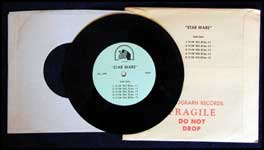
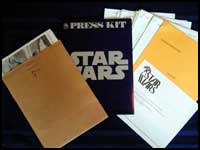
Also available to the media was the Star Wars presskit, which came in a navy blue folder with the title printed on the cover in silver. (I've seen a version of the presskit folder that uses the earlier "pointy W" logo, but was unable to determine whether the contents differed from those of the standard version.) Where the typical pressbook provided the media with "cut-and-paste" advertising material, the presskit usually provided any number of glossy stills (the number depending on the prestige of the intended publication), a production information guide, cast biographies, in-depth articles, and behind-the-scenes information. Some also came with a handful of color slides.
Finally, as with all major motion pictures of the day, the press were privileged to attend pre-release screenings of the movie in Los Angeles and New York. In addition to the presskit, a few additional items were produced exclusively for these events. A preview ticket was presented to lucky representatives of the press, such as then-Wall Street Journal writer Steve Sansweet, who would later fondly remember the ticket as his very first Star Wars collectible. (Thanks to Garry Pedersen for providing the photo of the ticket you see here.) A credit sheet resembling the presskit folder was also available, as well as a small adhesive name badge bearing the film's title and Fox logo. In addition to the press previews, charity and cast-and-crew screenings awarded attendees with a prized item: the Star Wars lucite paperweight, made in the form of a star, which was commissioned by Gary Kurtz through Two's Company. A similar star with the slogan "May the Force be with You" was also commissioned, but it's unclear if this was available prior to the film's release. These came in either a blue velvet pull-string bag or a flimsy plastic box with a film frame attached to it.
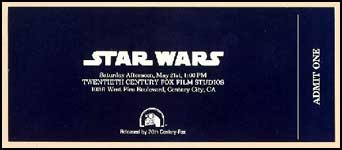
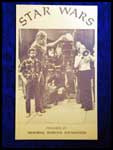
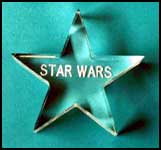
There were of course many promo items, such as lobby cards and posters, produced for theaters to display by May 25, but I personally catagorize these as general-release items. One noteworthy detail the collector should be made aware of is that the earliest theater promos were designated with the number 77-21-0. Later copies lacked the "0" at the end of the sequence.
There's a certain mystique surrounding those items that were released before Star Wars even hit theaters. They are the tangible representatives of the ground-floor idealism fostered by those few who were lucky enough to be involved with the project from its inception. Since most of us couldn't be there, these few items are the closest we will ever come to those idealistic times just before the world would be introduced to the story of a boy, a girl, and a universe.